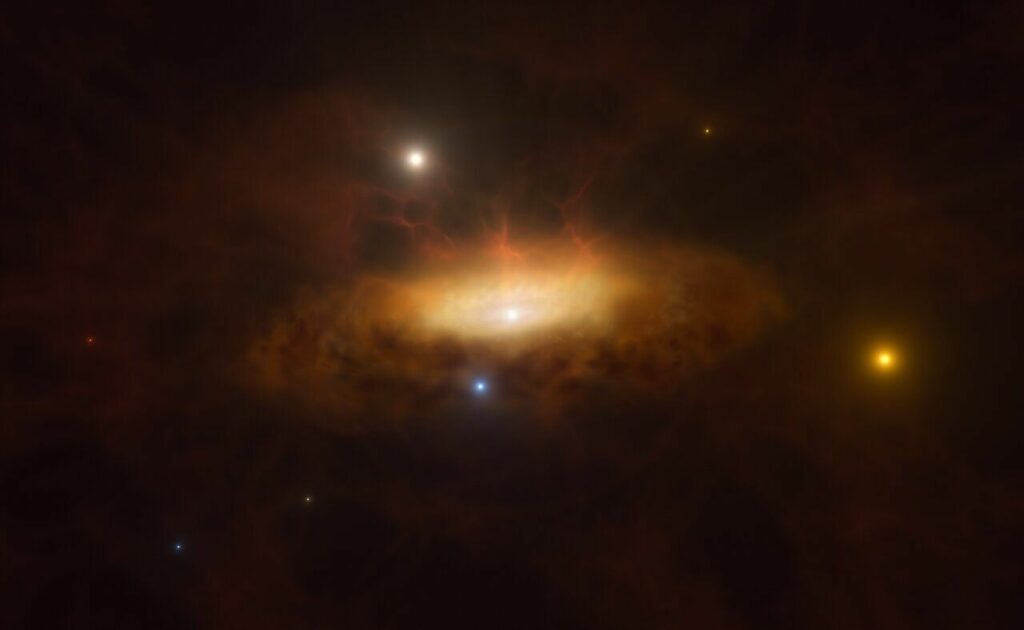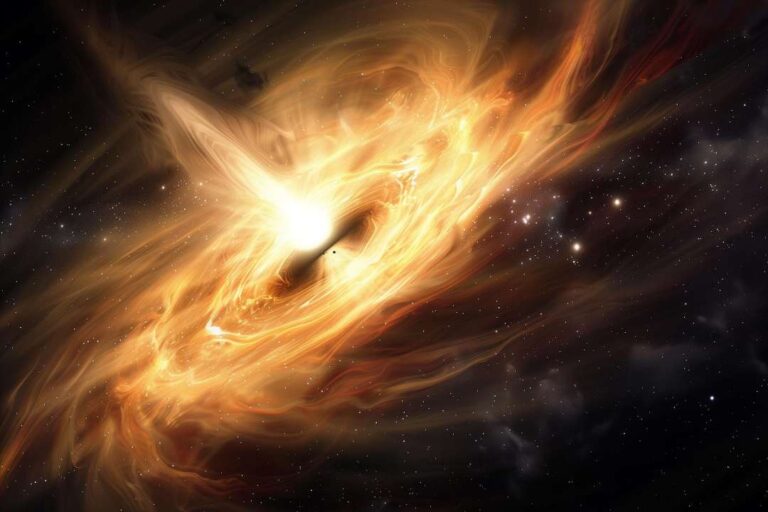Astronomers observe a colossal black hole coming to life in live feed.
From a humble unobtrusive galaxy known as SDSS1335+0728, astronomers witnessed a sudden brightening spurt like no other observed beginning sometime in the later half of the year, 2019. Scientists have employed data obtained from different space & ground observatories like the Very Large Telescope – ESO’s VLT to detect the changes in galaxy’s brightness level. The data obtained in a recent study show that the changes observed in the galaxy are unprecedented and could be a result of wake-up of the large black hole within the galaxy.
Paula Sánchez Sáez of the European Southern Observatory in Germany, author of the paper to be published in Astronomy & Astrophysics describes the situation as follows: “You have been watching a galaxy far away for years, and in your data it looks quiescent, passive as if nothing exciting can happen there –there isェam, then the center of this galaxy begins to act as if its brightness oscillation were within active galactic nucleus
Converting SDSS1335+0728 as an AGN object, there appears an immense enhancement in December 2019. Sometimes galaxies Swift observes could brighten up because of events like supernova explosions or tidal disruptions, though these are momentary occurrences. SDSS1335+0728 is still on the rise as it was seen in the earlier months of this year and moving up to more brightness to today which is now over a period of four years from the 2007 spike. To the astonishment of paleontologists, the plainly differentiations in this galaxy which stands 300 million light-year away from earth in virgo constellation provide a different reason to the astronomers.
To explain such brightness differences, the team analyzed both archival data and the new observations from several facilities including the X-shooter mounted on the ESO’s VLT situated in the Atacama Large Area Operations Site in Chile. If they compared the data taken before and after December 2019, they have noticed that SDSS1335+0728 is radiating a much larger amount of light at ultraviolet, optical, and even infrared band. X-rays were also produced by the galaxy starting in February 2024.

“This behavior is unprecedented,” says Sánchez Sáez, who is also affiliated with the Millennium Institute of Astrophysics (MAS) in Chile.
“The most tangible option to explain this phenomenon is that we are seeing how the [core] of the galaxy is beginning to show activity,” says co-author Lorena Hernández García, from MAS and the University of Valparaíso in Chile. “If so, this would be the first time that we see the activation of a massive black hole in real time.”
Supermassive black holes are those that have a mass greater than one hundred thousand times the mass of the sun, and they are often located in the center of a galaxy, including the Milky Way.
As stated by one of the co-authors Claudio Ricci, from the Diego Portales University in Chile, these giant black holes are generally inactive and invisible. Nevertheless, in the case of SDSS1335+0728, the researchers managed to see the hard process of the awakening of a massive black hole. It suddenly started burning gas in its environment to produce light; that’s why it became brighter.
This phenomenon of a black hole waking up has never been observed before, as Hernández García mentioned. Prior work has suggested that galaxies that used to be dormant can turn active at some point in time, but this is the first time scientists have caught black hole blooming right in real time. Ricci, who is also an academic visitor at the Kavli Institute for Astronomy and Astrophysics, Peking University in China, posited that this too can happen for our own Sgr A*, the black hole at the center of our galaxy. However, the prospects of this happening are still vague.
Additional observations must be made in order to rule out other possibilities. Perhaps what is actually observed is a relatively slow tidal disruption event or it may be a new event altogether. If it is a tidal disruption event, then, it would be the longest and the least luminous event of this type ever observed.
In any case, the galaxy SDSS1335+0728 offers important clues to the formation and, in particular, to the growth of the black holes. Sánchez Sáez stresses that such a tool as MUSE mounted on the VLT or those on the future Extremely Large Telescope (ELT) will come in handy in explaining why the galaxy is brightening.
The findings of this research were published in a paper titled “SDSS1335+0728: The paper The awakening of a ∼ 106M⊙ black hole published in Astronomy & Astrophysics.
Reference: P. S’anchez-‘aez et. al, SDSS1335+0728: The awakening of a ∼ 106M⊙ black hole, Astronomy & Astrophysics (2024). DOI: 10.1051/0004-6361/202347957
Do not forget to share your opinion with us to provide you with the best posts !




0 Comments